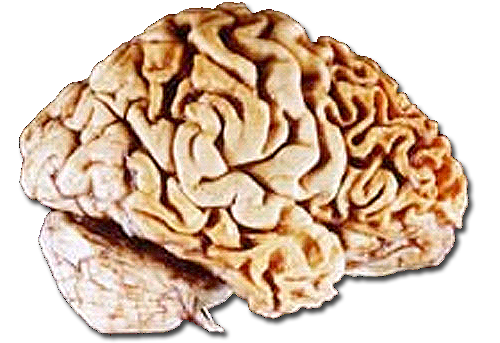Pick's disease management
| Pick's disease management | |
 | |
|---|---|
| A human brain showing frontotemporal lobar degeneration causing frontotemporal dementia. | |
| ICD-9 | 331.19 |
| OMIM | 600274 |
| DiseasesDB | 10034 |
| MeSH | D003704 |
Editor-In-Chief: C. Michael Gibson, M.S., M.D. [1]
Overview
Frontotemporal dementia (FTD) is a clinical syndrome caused by degeneration of the frontal lobe of the brain and may extend back to the temporal lobe. It is one of three syndromes caused by frontotemporal lobar degeneration.
Symptoms can be classified (roughly) into two groups which underlie the functions of the frontal lobe: behavioural symptoms (and/or personality change) and symptoms related to problems with executive function.
Behavioural symptoms include apathy and aspontaneity or oppositely disinhibition. Apathetic patients may become socially withdrawn and stay in bed all day or no longer take care of themselves. Disinhibited patients can make inappropriate (sometimes sexual) comments or perform inappropriate acts. Patients with FTD can sometimes get into trouble with the police because of inappropriate behaviour such as stealing.
Executive function is the cognitive skill of planning and organizing - patients become unable to perform skills that require complex planning or sequencing.
FTD can occur in patients with motor neuron disease (also known in the US as Lou Gehrig's disease or amyotrophic lateral sclerosis) in a small number of cases. The prognosis for people with MND is worse when combined with FTD, shortening survival by about a year.[2]
Because FTD often occurs in younger people (i.e. in their 40's or 50's), it can severely effect families. Patients often still have children living in the home. Financially, it can be devastating as the disease strikes at the time of life that are often the top wage earning years.
Pathology
A number of case series have now been published looking at the pathological basis of frontotemporal dementia. As with other syndromes associated with FTLD, a number of different pathologies are associated with FTD:
- Pick's disease (3-repeat Tau inclusions)
- Other tau-positive pathology including FTDP-17, corticobasal degeneration, progressive supranuclear palsy
- FTLD with ubiquitin positive, tau- and alpha-synuclein negative inclusions with and without motor neuron degeneration (recently characterized by nuclear and cytoplasmic staining of TDP-43 protein)
- Dementia lacking distinctive histology
- In rare cases, patients with clinical FTD were found to have changes consistent with Alzheimer's disease on autopsy
- Evidence suggests that FTD selectively impairs spindle neurons, a type of neuron which has only been found in the brains of humans, great apes, and whales
Imaging
Structural MRI scans often reveal frontal lobe and/or temporal lobe atrophy but in early cases the scan may seem normal. Atrophy may be asymmetric. Registration of images at different time points (e.g. one year apart) can show evidence of atrophy in two cross-sectional images that may be reported as normal. This is a useful diagnostic technique. However, many research groups are currently looking at ways of making an early diagnosis of FTD using other techniques (magnetic resonance spectroscopy, functional imaging, cortical thickness measurements etc.). FDG-PET scans classically show frontal hypometabolism, which helps differentiate from Alzheimer's disease. The PET scan in Alzheimer's disease classically shows biparietal hypometabolism.
Genetics
A higher proportion of FTD cases seem to have a familial component (perhaps more so than Alzheimer's disease). Two known mutations are associated with familial FTD: tau-positive frontotemporal dementia with parkinsonism (FTDP-17) with mutations in the MAPT gene on chromosome 17, and tau-negative frontotemporal lobar degeneration with ubiquintin-positive inclusions (FTLD-U; positive for TDP-43)with progranulin mutations (also on chromosome 17). However, it is estimated that each of these two genes only accounts for about 5-10% of all cases of FTD, thus other genes or heritable components are likely responsible for the high degree of heritability in FTD.
Management
There is no known curative treatment for FTD. Supportive care is essential. Management of behavioural symptoms may be necessary (e.g. SSRIs for depression; atypical neuroleptics etc.).
Further reading
- http://www.ftd-picks.org/ The Association for Frontotemporal Dementias
- Columbia University Update
- A collection of articles about Frontotemporal dementia in the journal Neurology
- Radin, Lisa. "What If It's Not Alzheimer's: A Caregiver's Guide to Dementia." Prometheus Books. 2003.
References
- Neary D, Snowden JS, Gustafson L, Passant U, Stuss D, Black S, Freedman M, Kertesz A, Robert PH, Albert M, Boone K, Miller BL, Cummings J, Benson DF. "Frontotemporal lobar degeneration: a consensus on clinical diagnostic criteria." 'Neurology' (1998) 51(6):1546-54. Available: [3]
- Neary D, Snowden JS, Mann DM. "Classification and description of frontotemporal dementias." Ann N Y Acad Sci (2000) 920:46-51. Available: [4]
- Kramer JH, Jurik J, Sha SJ, Rankin KP, Rosen HJ, Johnson JK, Miller BL. "Distinctive neuropsychological patterns in frontotemporal dementia, semantic dementia, and Alzheimer disease." Cogn Behav Neurol. (2003) 16(4):211-8. Available: [5]
- Rosen HJ, Gorno-Tempini ML, Goldman WP, Perry RJ, Schuff N, Weiner M, Feiwell R, Kramer JH, Miller BL. "Patterns of brain atrophy in frontotemporal dementia and semantic dementia." Neurology (2002) 58(2):198-208. Available: [6]
- Miller BL, Seeley WW, Mychack P, Rosen HJ, Mena I, Boone K. "Neuroanatomy of the self: Evidence from patients with frontotemporal dementia." Neurology (2001) 57:817-821. Available: [7]
- Diehl J, Ernst J, Krapp S, Forstl H, Nedopil N, Kurz A. (2006) [Misdemeanor in frontotemporal dementia] Fortschr Neurol Psychiatr. 74(4):203-10. [PMID 16671160]
- Seeley WW, Carlin DA, Allman JM, Macedo MN, Bush C, Miller BL, Dearmond SJ. (2006) Early frontotemporal dementia targets neurons unique to apes and humans. Ann Neurology.
See also
- Frontotemporal lobar degeneration
- Pick's disease
- Semantic dementia
- Progressive nonfluent aphasia
- Alzheimer's disease
- Corticobasal degeneration
Template:SIB de:Frontotemporale Demenz nl:Frontotemporale dementie sv:Frontallobsdegeneration av icke-Alzheimer Template:WH Template:WS